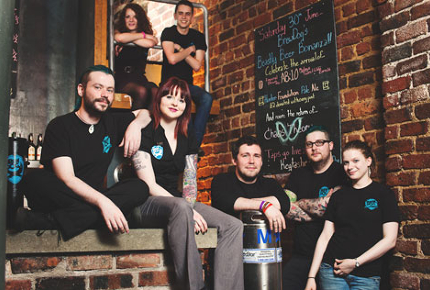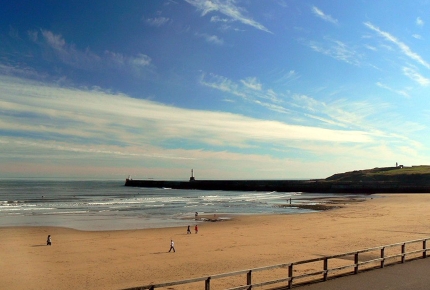Is Aberdeen Scotland's most dismal city?
Aberdeen has just been named Scotland’s most dismal place, but are things really that bad? Nick Bruno investigates.
“There’s definitely a much more positive atmosphere about the place since the football team stopped being so rubbish,” Phil Sim, a local Aberdonian, tells me.
He’s veered slightly off topic.
We were talking about Aberdeen being named Scotland’s most dismal town by Urban Ream Magazine and now we’ve moved onto football – football and beer.
But beer is an important part of the conversation.
When the Granite City was awarded the Plook on the Plinth Carbuncle award this week (‘plook’ means ‘pimple’ in Scottish), Urban Ream declared that Aberdeen was where “architecture comes to die” – but that’s not how the locals see it.
Certainly not at BrewDog, the trailblazing craft brewery that has its roots and headquarters in Aberdeenshire.
“Each city has its architectural fails,” James Watt, the BrewDog co-founder says phlegmatically, “Aberdeen is no different.
“I wouldn’t say it’s merited to tar the whole city as ‘dismal’ based on a few dodgy buildings. The oil industry has massively impacted on the cityscape, and it’s inevitable that people will have views about the architecture and expansion. That’s part and parcel of being a growing city, I accept it and love it.”
BrewDog’s deconstructed, bare brick bar serves over 100 brews and is one of a growing number of success stories. It sits just around the corner from two relative newcomers: Six Degrees North, which creates natural Belgian-style beer, and the nearby Bottle Cap Brewery with its feisty tipples and live music.
 Aberdeen-based BrewDog sparked a craft beer revolution
Aberdeen-based BrewDog sparked a craft beer revolutionBrewDog Aberdeen
The merchants who built Aberdeen had money and style.
It was a rich city, a city of solid, striking granite buildings and one that took great pride in itself. Saunter along Aberdeen’s older parts, around the back of the Kirk of St Nicholas and down King Street, onto the university, and you’re still wandering among some of the most handsome streets in the UK.
Up until the 1980s, Aberdeen was famed for its rose-lined streets and gardens, and it topped the table in Britain in Bloom awards year after year. But the abundance of flowers are no more and some of Aberdeen’s older buildings have been torn down and replaced with shopping malls and sad office blocks.
David McCracken, Print Curator at Peacock Visual Arts, thinks the Plook award is welcomed as it stimulates debate. Though he does believe that the city needs “a good scrub”.
David sees much aesthetic allure in Aberdeen’s past, present and future. He points to Gray’s School of Art (inspired by Mies van der Rohe's modernism) and Aberdeen Art Gallery’s rooftop extension plans, as fine examples.
The Granite City also has a flourishing arts scene with venues such as Lemon Tree and The Tunnels hosting performing arts, comedy and music. Aberdeen’s growing reputation for craft beer and good food also shows how the appetite of Aberdonians is reinvigorating areas such as the Merchant Quarter.
 Aberdeen's live music and arts scene is far from dismal
Aberdeen's live music and arts scene is far from dismalCreative Commons / Iain Smith
Both James Watt and BrewDog co-quaffer, Sarah Warman, love underground drinking hole The Tipping House, while Aberdonian bon viveurs have even more options at CASC Bar on Stirling Street, which is famed for its cigars, ales, scotch and coffee - and has Britain's most northerly walk-in humidor.
“When I started visiting Aberdeen,” explains Sarah, “half those places weren't yet a reality, so it's changed a lot in four short years and there's clearly a lot more development to come.”
Aberdeen’s restaurateurs are also getting in on the act. The seafood at Moonfish Café, run by Masterchef finalist Brian McLeish, is garnering rave reviews both locally and nationally. And with a busy fish market on the harbour steps, there’s scope for more.
Back in the Merchant Quarter, Café 52 is in the fine-looking stone-built surrounds of the Green, while Musa, a restaurant, art gallery and live music venue, is set in an old banana-ripening warehouse and church.
Rosemount, an area northwest of the city centre, has lots of independent outlets from Herd’s the Butcher, famed for its pies, to vintage emporium Peapod. Viaduct bars in the district, like the Masada, Cellar 35 and the Noose and Monkey, are all good for live music.
Towards the sea, visitors can enjoy Aberdeen’s maritime history. At the harbour community Footdee (pronounced Fitee), fishermen’s single-storey dwellings and colourful sheds show the Aberdonian gift for improvisation.
 Aberdeen’s gorgeous beach is, apparently, ripe for epiphanies
Aberdeen’s gorgeous beach is, apparently, ripe for epiphaniesCreative Commons / Nick Bramhall
The excellent Silver Darling restaurant (named after the herring catch that once fuelled the east coast) is now approaching its 30th year. Frenchman Didier Dejean recognised its beauty when he built his conservatory dining area over a custom house in 1986 and diners can still watch harbour ships, seals and dolphins while eating the catch of the day.
Hopefully, the Plook on the Plinth Carbuncle award will be a wake-up call to the city council planners. Like many cities that have chased development and accommodated change, Aberdeen seems to have lost sight of the beauty and pride that makes a city great.
According to James Watt, an invigorating walk along Aberdeen’s gorgeous beach is ripe for epiphanies. With a mischievous Doric twist, James distils: “We’re the happiest people in the UK, according to an equally dubious report.”
One can’t help but wonder if that’s true as well. Least not for Phil Sim who joined 80,000 others in the streets when Aberdeen FC paraded the League Cup last March.
Do you have any Feedback about this page?
© 2025 Columbus Travel Media Ltd. All rights reserved. No part of this site may be reproduced without our written permission, click here for information on Columbus Content Solutions.









 You know where
You know where